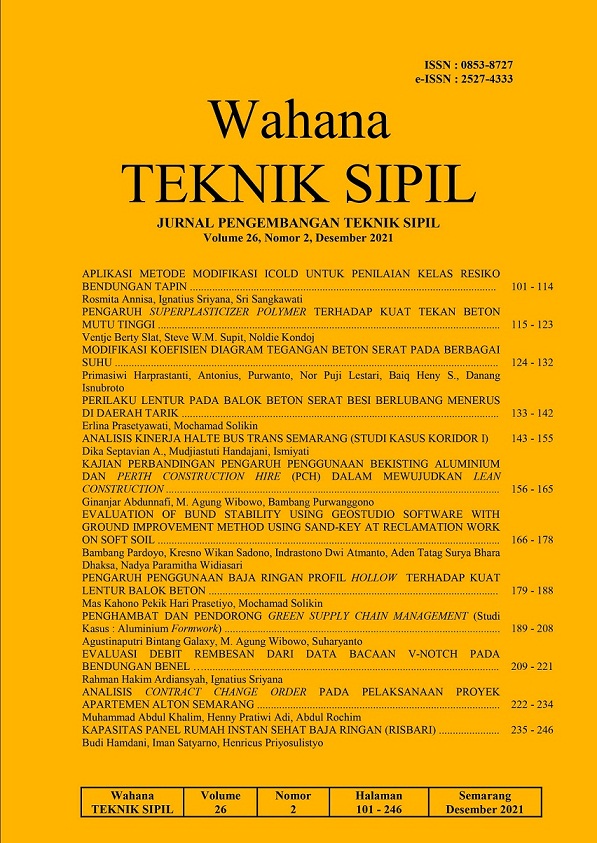KAJIAN PERBANDINGAN PENGARUH PENGGUNAAN BEKISTING ALUMINIUM DAN PERTH CONSTRUCTION HIRE (PCH) DALAM MEWUJUDKAN LEAN CONSTRUCTION
DOI:
https://doi.org/10.32497/wahanats.v26i2.3130Keywords:
aluminium formwork, cost, quality, time, waste, HSEAbstract
Technological developments have led to innovations in construction materials science, one of which is formwork materials. There are several important aspects in formwork innovation, namely cost, speed, quality, waste, and health safety environtment (HSE), but they have not fully had a positive impact on construction project development. However, it has not fully had a positive impact on construction projects. In addition, what aluminum formwork manufacturers offer so far may not necessarily suit the needs of customers. The purpose of this study is to analyze the comparison in terms of cost, time, waste, and HSE between projects using aluminum formwork and the same project simulated using Formwork Perth Construction Hire (PCH). In this study: (1) simulation on the project if the project uses PCH formwork (2) comparative analysis of products in terms of time, cost, quality, waste, HSE on real projects using aluminum formwork with projects that have been simulated using PCH formwork. The effect of using aluminum formwork when compared to a simulation project using PCH formwork: (1) in terms of the time it can provide 25.92% savings on the total duration of the simulation results project, (2) in terms of costs, it can provide a total cost savings of IDR 895,756,004,00 (3) in terms of quality, the use of aluminum formwork is stronger, durable quality, and the results of the concrete molding are tidier than using PCH formwork (4) in terms of waste, projects that use aluminum formwork produce less waste than using PCH formwork. PCH formwork. (5) in terms of HSE, aluminum formwork is safer, more environmentally friendly because it has minimal waste, and is safe for workersReferences
Cho, Han-Wook., Roh, Song-Geun., Byun, Young-Min., Yom, Kyong-Soo, 2004, Structural Quantity Analysis of Tall Buildings, CTBUH Conference Proceedings, Oct. 11-13, Seoul Korea.
Hanna, Awad S., 1999, Concrete Formwork System. University of Wisconsin: Marcel Dekker, Inc.
Husen, A., 2009, Manajemen Proyek. Edisi Revisi Diterbitkan oleh Penerbit CV. ANDI Yogyakarta.
Koskela, L., 1997, Lean Production in Construction, In Alarcon, L. F. (ed), Lean Construction, AA Balkema, Rotterdam, pp. 1-9.
Mc Cormac, Jack C., 2004, Desain Beton Bertulang-Edisi Kelima-jilid 2, Erlangga, Jakarta.
Rosnani, Ginting, 2010, Perancangan Produk. Graha Ilmu, Yogyakarta.
Ruslan, Ujang, 2011, Analisis Bekisting terhadap Waktu Siklus Pengecoran Lantai Pada Gedung Bertingkat, Tesis Magister Teknik Sipil Universitas Diponegoro, Semarang.
Sandagie, Edwin, 2015, Analisis Perbandingan Pengaruh Penggunaan Flyslab dan Plat Floordeck dalam Mewujudkan Lean Construction. Tesis Magister Teknik Sipil, Universitas Diponegoro, Semarang.
Sitinjak, B.W., Arsianto, Y., Wibowo, M.A., dan Kristiani, F., 2015, Pengaruh Penerapan Metode Lean Construction pada Biaya Pekerjaan Struktur Tipikal. Jurnal Karya Teknik Sipil Volume 4 Nomor 4 Tahun 2015. Universitas Diponegoro.
Soeharto. I., 1995, Manajemen Proyek Dari Konseptual Operasional, Erlangga, Jakarta.
Tim Proyek the Ayoma Apartement, 2018, “Alform effect” perubahan paradigma utk efektivitas pelaksanaan proyek gedung. Tim Proyek the Ayoma Apartement : Tangerang.
Trijeti, 2011, Studi Perbandingan Bekisting Konvensional dengan PCH. Jurnal Konstruksia Volume 3 Nomor 1 Desember 2011.
Tutuhatumewa, Alfredo, 2010, Aplikasi Metode Quality Function Deployment dalam Pengembangan Produk Air Minum Kemasan. Jurnal Program Studi Teknik Industri, Universitas Pattimura, Ambon. 04 (01). 11-19.
Downloads
Published
Issue
Section
License
Authors who publish with this journal agree to the following terms:Authors retain copyright and grant the journal right of first publication with the work simultaneously licensed under a Creative Commons Attribution License that allows others to share the work with an acknowledgement of the work's authorship and initial publication in this journal.
Authors are able to enter into separate, additional contractual arrangements for the non-exclusive distribution of the journal's published version of the work (e.g., post it to an institutional repository or publish it in a book), with an acknowledgement of its initial publication in this journal.
Authors are permitted and encouraged to post their work online (e.g., in institutional repositories or on their website) prior to and during the submission process, as it can lead to productive exchanges, as well as earlier and greater citation of published work (See The Effect of Open Access).






